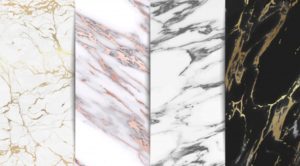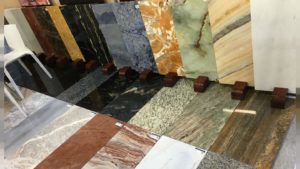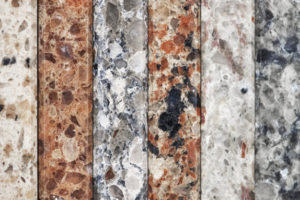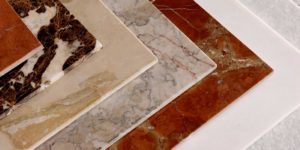Construction stone processing industry
Besides export and import, fund attraction and allocation to industrial and production projects, pouresh investment development group had a successful experience in importing full production line and machinery of Omid Abade mine in Fars provienece. Fortunately, Iran provides good facilities for investors in natural resources.This article explains our valuable experience about this lucrative industry.

Investment in construction and decorative stone processing industries
Decorative stones belong to one of the groups of igneous, metamorphic or sedimentary rocks in lithological classification. These rocks include marble, marmarit, porcelain, conglomerate, travertine, sandstone, granite, diorite, syenite, gabbro, and some less important rocks

Physical features of masonry and decorative stones
Masonry and decorative stones are known for their physical features. These features are mainly:
Hardship
The hardness of construction and decorative stones is very high. It ranges from the lowest degree of hardness, talc, to the highest hardness of granite, which is even harder than steel. The amount of hardship affects the price of the finished stone. Generally, the harder stone needs longer time for extraction, cut and polish its components.
Colour
The colours each give the stone its own beauty and texture, and people certainly prefer the look of the stone in addition to its strength, character and ease of use.
The exterior colours add to the beauty of the city. In this regard, light colours usually take precedence over dark and opaque colours.
Needless to say, the colour of the exterior of the buildings, which is influenced by the type of materials used (stone or non-stone), is itself affected by atmospheric factors. Rainwater can chemically affect the existing rock minerals and
change its colour.

The porosity amount
The porosity is increased by the penetration of rainwater into the rock cavities and freezing. These cavities are often formed by the chemical influence of natural solutions on some minerals in the rock. In sub-zero winter weather, water that infiltrates the rock pores or sometimes the back of the rock is frozen, causing major cracks in the rock. These cracks increase steadily until all or part of the rock is broken or fallen.
Resistance
The resistance of the rock is constantly changing due to various factors such as weathering, cold, heat and fire. Weathering agents are sometimes chemical.
These can be gases such as SO2, O2 and CO2. In cities where such gases are abundant in the air, the facades of the building blocks are more likely to be affected by them.
Some weathering factors, such as freezing and thawing inside the stone cavities, have the effect of decolorizing and the thermal effect of sunlight physically affecting the stone.
It is necessary to explain that chemical and physical weathering agents act together and cause discoloration, breakage, and detachment of the stone.
Limestone, especially travertine, in areas with high rainfall and excessive carbon dioxide in space, is not suitable for exterior buildings

Building and decorative stone types
Surface Stones
Compact lime, sandstone, Alvan representatives marble, volcanic tuff, granite, syenite, diorite, labradorite, gabbro, basalt and other builder stones using consistent builder.
Wall cladding stones
Lime, dolomite, sandstone, gypsum, volcanic tuff.
Interior facade stone
Standard polished marble, gypsum, tuff, shear, carbonate cement conglomerate.
Stones with special industrial purpose applications:
Paving the Power in Control
Soapstone (talc, talc schist), tuff, andesite, basalt, diabase.
Throw in powerful stones
Granite, diorite, quartzite, siliceous sandstone, andesite, trachyte, basalt, diabase, felsite.
Powerful stones against the alder
Dense lime, dolomite, magnesium, calcareous sandstone.
Services of rock consulting
Marble, granite, labradorite.

Scientific classification of all kinds of decorative and façade stones
Suitable stones for stone and decorative stone production are classified under the following general headings:
- Sedimentary rocks
Conglomerates and sandstones
Conglomerates can be used as interesting decorative stones if they are thick and fully cemented.
Conglomerates with elements that are calcareous and cementitious, and have a good contrast between the colour of the cement and the background, will be more ideal.
If the main elements of these rocks have different quality and properties, the cutting operation will face drawbacks. For example, if some elements are siliceous and some are calcareous or the elements are silica and calcareous cement.
Sandstones can also be used as a construction stone if the layers are thick, calcareous or completely clad with limestone cement.
Such stones are especially used in mullions.
Limestone or dolomitic rocks
Limestone is the major building and decorative stone. Their prominent features are, in short, good hardness, high cutting ability, colour variety, good strength and easy extractability.
Travertine
Travertines are the product of old limestone springs. Among them, white travertines, which have uniform veins of colour and pores, are the best.
Cream travertines, whose colour is due to the presence of pigments dispersed by iron oxide in the rock textures, are of lesser quality.
Coloured travertines that have redox, walnut, lemon and iron oxide dyes in different layers due to differences in iron oxide contamination in different layers are very attractive.
In general, coloured travertines are well priced and marketed in the current world market conditions.
Travertine is considered to be one of the most widely used stones due to its acceptable toughness, shear and polish ability, good extraction conditions, attractive appearance, porosity for full adhesion to mortar and especially good price compared to other stones.
Marble
Marbles, such as travertine, also occur as a result of the function of lime spa springs. Marble is usually found in layers between layers of travertine.
In the hot springs operation process, travertine is formed if the water temperature drops slowly, aragonite and if the temperature drops rapidly.
In Iran, stone is called marble. Its brand of colour is Enix.
The marble contains green, lemon, yellow and so on, which, after wear, looks like a luxurious decorative stone.
Major marble uses include luxury wall coverings, interior decoration, sculpture and stone tables.
In Iran, Esfand and Talenguyeh mines in Sirjan, Deh Rostam Kerman, Narrow Water, Zarsahr, Abbas Abad Jolfa and several other mines are potential mines of this rock in the country. At present, Durrak or Borg and Sefidokoh Yazd province and Mouteh mine are actively exploited.
B- Igneous rocks
Granite
Granites are among the igneous rocks that have been introduced in the global market in recent decades as luxurious and expensive decorative stones.
These types of stones are important in terms of their hardness, transparency and stunning beauty. Granites that are not affected by alteration and are not affected by tectonic phenomena, especially micro tectonics, which are attractive in colour, are considered as ornamental stones and facades.
It should be noted that granite cutting and abrasion are much more difficult and costly than limestone. So that only special disks and rockers can cut and wear them. Bright, red and pink granites are very valuable because of their colour. Khoy district red granites in West Azerbaijan are a prominent example of this type of granite. Gray granites are of variable quality, depending on the degree of darkness, lightness, and grain size or the same minerals.
Shirkouh granites in Yazd and Alvand in Hamadan have a wide range of different types of granites, with different colours and textures
Rhyolites
If rhyolites have a relatively lower percentage of quartz and pink fused potassium feldspars, they are more desirable and have a beautiful pink appearance. In general, non-alder rhyolites are found less frequently.
Specific igneous rocks
Specific igneous masonry and decorative rocks can be syninites, diorites, gabbros and their equivalent outcrops of trachites, andesites, basalts, and other rocks such as nepheline syenites, peridotites, pyroxenites and other amphibians.
These types of stones can be considered as special decorative stones if they are completely fresh and not altered and also exhibit beautiful colours in polished sections.
(C) Metamorphic rocks
Marbles and gneisses are two types of metamorphic rocks that are suitable for use as construction and decorative stones.
Marmarite
Marbles of metamorphic white, gray and coloured stones, with recrystallization, have a special luster and transparency.These types of rocks, derived from the metamorphism of early limestones, may form different ornamental stones with different names and textures, depending on the degree of metamorphism and the growth of crystals.
Coarse-grained, white or light gray marble to the cream is called “Chinese stone”. The famous mines of Hana (Nairiz-Fars Province), Najaf Abad, Crystal and Chinese Oligodarz, Ley Bid and Red Goddard of Mouteh are among the famous mines of Iranian stone.
Yazd’s Top Ten Mine is one of Iran’s famous fine crystal marble mines. The degree of crystallization, whiteness and colour uniformity are among the most important factors of this rock

Gneisses
Gneisses, such as granites, are exceptional decorative stones because of the beautiful eye texture seen in some of the polished sections, if they have ideal colours and coarse and no-trace elements.
Among existing rocks, most of the ore was used as cover and interior of the floor of some buildings, especially mosques and sanctuaries. But in later years, in addition to marble, the use of travertine and marble and eventually igneous rocks such as granite and syenite has become commonplace on the exterior of buildings.Applying stone to the interior and exterior of buildings, in addition to its exterior beauty, enhances the durability and durability of buildings, extends the life of buildings and contributes to the environmental health of building occupants.
We hope this post helps you to invest in the stone processing industry and provides a background for you to work in this industry.
